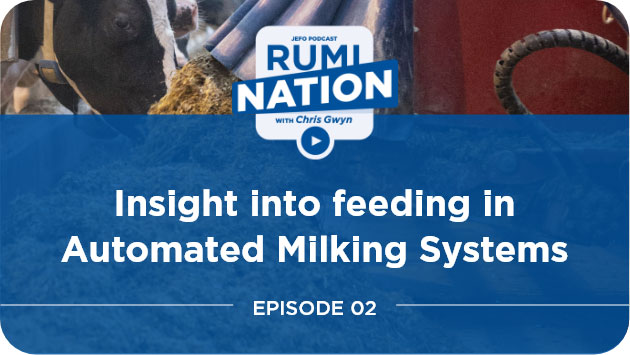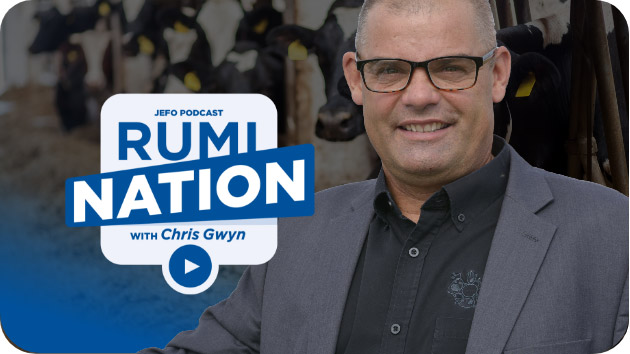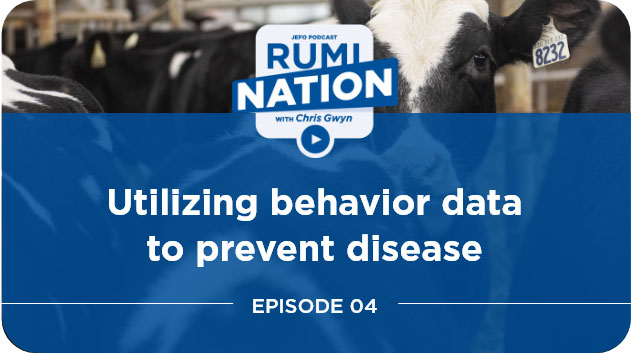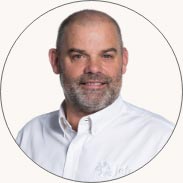RumiNation | S1 : EP3
Managing Hoof Trimming to Prevent Chronic Lameness
Brought to you by Jefo Nutrition
Share now!
Did you enjoy this episode?
Share now!
Managing Hoof Trimming to Prevent Chronic Lameness
Chronic lameness on the dairy farm is an issue that can be resolved with proper, timely hoof trimming. But how often should we trim a cow? When should we do it? What do we know about the cause of lameness?
Get answers with hoof care consultant Jamie Sullivan.
Our guest - Jamie Sullivan
Hoof care consultant and owner of Rippleview Hoof Care in Manitoba.
Specialization
- Preventive & therapeutic hoof care
- Digital dermatitis prevention strategies
- Proper Cattle Handling & hoof trimming training
- Cow comfort and facility assessments
- Research in lameness prevention

Timestamps & Summary
01:03:00 – What got you in the first place in this essential area of cattle health?
It wasn’t Mr. Sullivan’s dream to be a hoof trimmer. When he was a kid, he wanted to be a vet, and then wanted to own a dairy farm and milk his cows. When he was studying animal science at the university, he came across a trimming school in Ontario. He decided to take the school simply to trim his own cows, as he experienced having cows left with more lameness after the trimmer came in. He started in the trimming business this way and simply never quit.
He has no regrets: It took him around the globe as he got into doing training and consulting. No matter where you go, when we talk about lameness and cow comfort, it’s fairly similar. Everyone is trying to get control of the 3 main lameness issues: digital dermatitis, white line disease and sole ulcers.
03:48:00 – What’s the current situation in Canada when it comes to cattle lameness?
Mr. Sullivan says that the numbers haven’t changed since 1994 (around 30% of lameness incidents). They discovered that a lot of those lameness are repeated cases or cases that we never completely healed for the same cows. Where they are heading in the industry now is to not only prevent lameness in the first place, but also prevent them from happening again.
05:05:00 – What do we need to do?
Mr. Sullivan explains that it comes down to prevention, but there’s more.
As the herds are getting larger, we need a plan between the trimmer visit to prevent lameness from happening.
There’s also the optimal time to trim, which is just before going dry or at the start of dry-off.
Then there’s the frequency: How often do we have to trim a cow? Mr. Sullivan says that 2 or 3 times a year is usually good, but that every farm and cow is different. Some cows may only need a dry-off trim. Others that have had lameness before might need 3, 4 or 5 trims a year to keep them healthy and prevent other lameness. Most of Mr. Sullivan’s clients have a weekly, bi-weekly or monthly schedule, and he can trim between 50 and 70 cows each visit. The optimal trim schedule has to be found for each farm and each cow, and records have to be kept.
The most important piece of equipment for trimming now is the computer, as the trimmer needs to know what needs to be changed or monitored on the farm to prevent lameness for chronic cows.
08:14:00 – Is there any other thing management wise that we should be doing to prevent chronic lameness?
We always say that digital dermatitis is a hygiene issue: If your farm has a lot of white line lesions, it’s probably a trauma issue. It leans towards standing time, but what is found in the industry is that inflammation has a huge role in lameness and probably a lot of that is happening at transition and calving. Hormonal changes cause ligaments to loosen naturally, which causes damage. That’s why dry cow trims are of the utmost importance.
We need to see zero lameness in our transition dry cow pens if we want to see close to zero lameness in the lactating herd.
10:24:00 – Those are some take-home points for dairy producers, nutritionists, veterinarians and advisors. Any other points when it comes to lameness and chronic lameness?
We can never do enough for stalls and cow comfort, make sure your cows are lying down. Also, one-on-one communication between the trimmer, nutritionist and vet is key to come up with a joint plan and work as a team to achieve what works with the management that clients have in the farm.







